
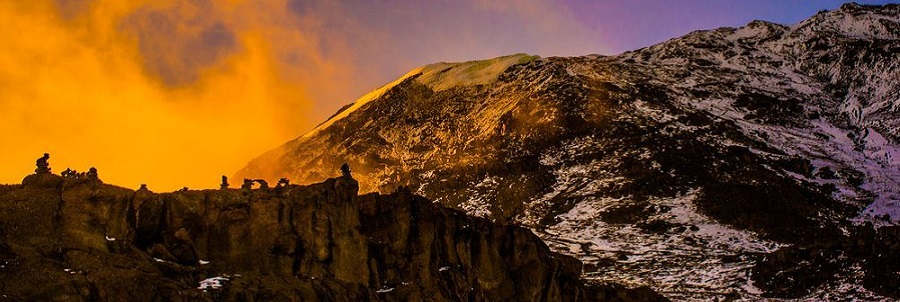
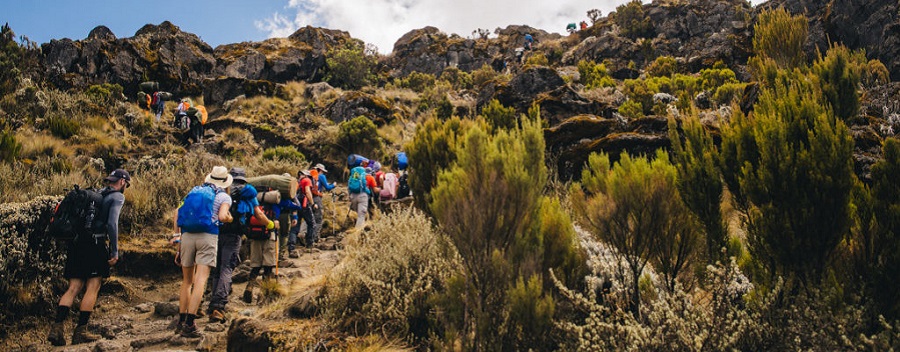
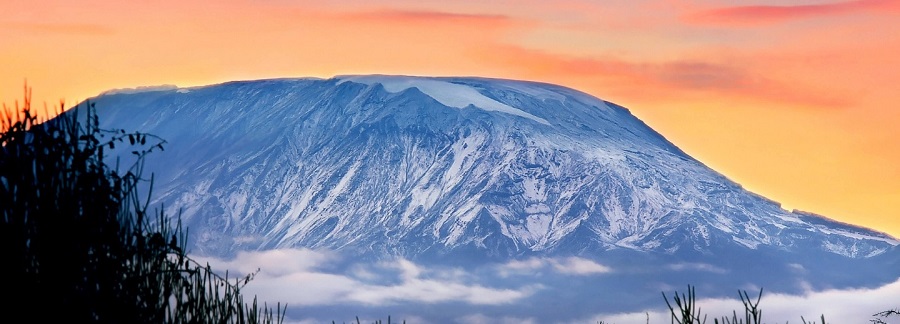
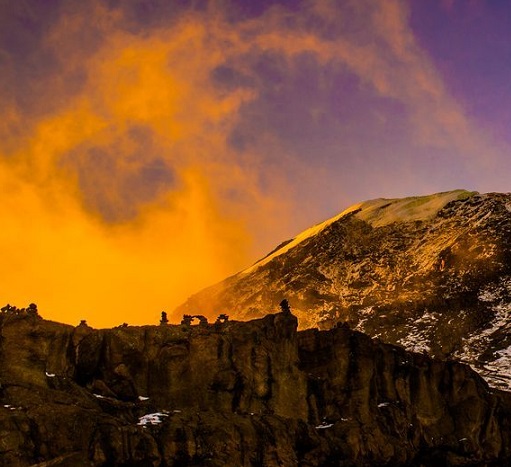
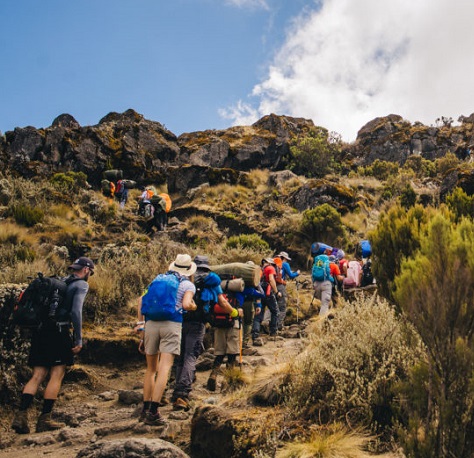
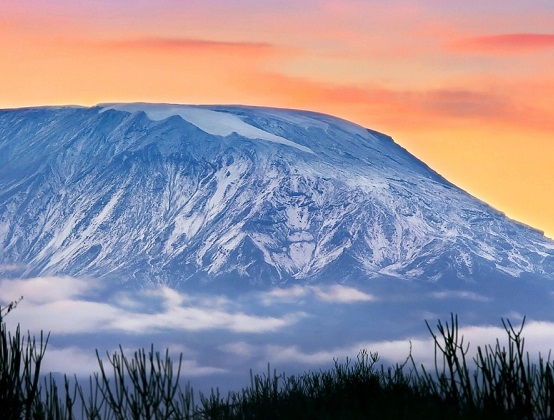
Mutige erfahrene Kletterer, die Abenteuer und Herausforderungen suchen, werden auf Umbwe genau das finden, was sie wollen. Ein kurzer steiler Aufstieg durch alle Klimazonen - vom tropischen Regenwald bis zum ewigen Eis - wird Ihre Kraft und Ausdauer auf die Probe stellen. Wie keine andere Route auf dem Kilimandscharo vermittelt Umbwe denjenigen, die den Gipfel erreichen, ein Erfolgserlebnis.
Ihr erster Tag auf dem Berg beginnt am Umbwe-Tor und führt Sie auf einem langen Weg zum ersten Camp auf Ihrem Weg - dem Umbwe-Camp. Trotz der Herausforderung, die Umbwe für Wanderer darstellt, wird eine gut durchdachte Lage der Lager zur richtigen Akklimatisation beitragen.
Die Wanderung durch Umbwe ist nur als 6-tägiges Programm verfügbar. Empfohlen nur für erfahrene Wanderer in guter körperlicher Verfassung.
Ihr Guide und Ihre Steigunterstützung treffen am Morgen in Ihrem Hotel ein. Einführungen und eine letzte kurze Überprüfung der Ausrüstung gehen Ihrer Fahrt zum Umbwe-Tor des Kilimanjaro-Nationalparks voraus. An diesem Eingang auf 1.640 m Seehöhe beginnt Ihre Wanderung. Der Head-Guide wird die Genehmigungen und die Registrierung für Such- und Rettungsdienste abschließen. Ihr erstes Tagestrekking soll Sie zum Umbwe Camp für Ihren ersten Berg über Nacht bringen. Das Klettern auf 2.930 m ist eine Langstrecke mit einem deutlichen Höhenanstieg. Finden Sie also das richtige Tempo für die gesamte Gruppe und bleiben Sie dabei. Vergessen Sie Ihren Regenmantel nicht, da dieser Teil der Umbwe-Route durch Regenwald mit der Wahrscheinlichkeit von Regenschauern führt. Ihre Support-Crew wird das Camp und das Abendessen vorbereitet haben, wenn Sie dort ankommen. Da dies die erste Nacht der Gruppe auf dieser Höhe ist, empfehlen wir Ihnen, ab jetzt die folgenden Regeln zu befolgen: - Konsumieren Sie keinen Alkohol und minimieren Sie Ihre Koffeinaufnahme - Trinken Sie nicht weniger als 4 Liter Wasser pro Tag, um sich mit Feuchtigkeit zu versorgen. Nehmen Sie es in kleinen Mengen aber häufig ein - Wir empfehlen unseren Kunden, Diamox morgens vor dem Aufstieg des Tages zu verwenden. Dies reduziert die Symptome der Höhenkrankheit. Fragen Sie Ihren Arzt nach Diamox, bevor Sie das Haus verlassen. Nächtliche Beschwerden gehen oft mit einer Akklimatisation einher. Obwohl Symptome wie Kopfschmerzen und Übelkeit häufig sind, informieren Sie Ihren Reiseleiter unverzüglich darüber.
Frühes Aufwachen, Frühstück und Beginn des Trekkings zum Barranco Camp. Der Regenwald weicht schnell dem Bürsten und wenn es nicht zu bewölkt ist, können Sie den Vulkan Meru zum ersten Mal sehen. Das Trekking auf der Umbwe-Route für diesen Tag ist von mäßiger Länge. Gegen Mittag erreichen Sie das Barranco Camp (3.960 m), das sich in einem riesigen Vulkanbruch befindet. Hier wird ein Mittagessen angeboten, und dann haben Sie die Möglichkeit, sich für den Rest des Tages zu entspannen, was den Akklimatisierungsprozess erheblich erleichtert.
Frühes Aufwachen, Frühstück und Beginn des Aufstiegs zur Barranco-Mauer (wir empfehlen, das Camp so früh wie möglich zu verlassen, um Menschenmassen der anderen Gruppen zu vermeiden). Das Wandern entlang der Schluchtwand ist nicht schwierig und dauert nur etwa eine Stunde. Nach dem Aufstieg können Sie sich vor dem Kibo-Vulkan ausruhen und Fotos machen. Dann beginnen Sie eine schwierigere Wanderung zum Karanga Camp, das während der Route zahlreiche Auf- und Abfahrten bietet. Aber keine Sorge: Unsere Guides sind Experten für die Auswahl eines optimalen Tempos für die Gruppe. Nach Erreichen des Lagers wird Ihnen ein warmes Mittagessen angeboten. Nach ein paar Stunden müssen Sie eine Akklimatisierungswanderung in Richtung Barafu Camp mit einem Höhenunterschied von 200 Metern absolvieren und dann wieder hinunter zum Camp absteigen. Hinweis: Die Akklimatisierungswanderung ist eine einfache Wanderung mit leichtem Höhenunterschied, um den Akklimatisierungsprozess zu beschleunigen. Sie sollten die Akklimatisierungswanderungen sehr ernst nehmen. Sie erhöhen Ihre Chancen, den Kilimandscharo erfolgreich zu besteigen, und bewahren Sie vor den Folgen der Höhenkrankheit.
Am Morgen nach dem Frühstück machen Sie sich auf den Weg zum Barafu Summit Camp (4.640 m), dem Ausgangspunkt für eine Nacht auf dem Uhuru Peak (5.895 m). Unser Team wird im Voraus ein Camp für Sie einrichten, einschließlich Zelten und Schlafsäcken, damit Sie sich entspannen können. Nachdem Sie wieder zu Kräften gekommen sind, müssen Sie eine Akklimatisierungswanderung zum mittleren Kosovo-Gipfellager (4.800 m) und zurück zum Barafu-Lager absolvieren, wo Ihnen ein warmes Abendessen serviert wird. Es ist besser, den Rest des Tages vor dem nächtlichen Gipfel auszuruhen und zu schlafen.
Die Gruppe verlässt das Barafu Camp und die Höhe von 4.640 m gegen Mitternacht. Diese Nacht klettern Sie auf 5.895 m am Uhuru Peak. Die Höhe stellt auf dieser Wanderung trotz der relativ einfachen Wanderung eine Herausforderung dar. Alle zwei Kletterer in der Gruppe werden von einem Führer begleitet, dessen Aufgabe es ist, ihre Fitness für den Aufstieg ständig zu überwachen. Wenn Sie den Uhuru Peak erreicht haben, können Sie auf einem der Gletscher des Kilimanjaro wandern. Die Gruppe kehrt dann für eine 2-stündige Pause zum Barafu Camp zurück, bevor sie im Millennium Camp auf 3.820 m absteigt. Bitte beachten Sie, dass der Abstieg zwar Erleichterung aus großer Höhe bringt, aber auch die meisten Unfälle (bis zu 90%) passieren. Es ist leicht zu vermeiden, zu fallen und möglicherweise ein Glied zu brechen sowie Ihre Zehennägel zu beschädigen, wenn Sie nur auf Ihren Schritt achten.
Das Millennium Camp liegt inmitten eines Regenwaldes. Eine geringere Höhe und die damit verbundene Linderung der Auswirkungen der Höhenkrankheit sowie die Erkenntnis, dass Sie Ihr Ziel erreicht haben, sorgen für einen guten Schlaf. Die Gruppe wird sich nach Beendigung des Frühstücks auf die letzte Etappe der Reise in Richtung Mweka Gate Park (1.640 m) begeben. Dies ist Ihre letzte Gelegenheit, Erinnerungen an den Aufstieg mit Ihren Guides und Ihrem Support-Team zu teilen. Sie erhalten Ihre Leistungsnachweise in unseren Büros, bevor Sie zu Ihrem Hotel zurückfahren.
o Parkgebühren,
o Campinggebühren
o Rettungsgebühren
o 18% Mehrwertsteuer auf Tourgebühren und Dienstleistungen, die fast 55% der berechneten Gesamtkosten kosten.
o Transport zum und vom Bergtor
o Professionelle Bergführer, Köche und Träger
oder 3 Mahlzeiten täglich am Berg
o Gefiltertes Wasser während der gesamten Wanderung
o Faire Löhne für die Bergbesatzung, wie von der Kilimanjaro National Park Authority (KINAPA), der Kilimanjaro Association of Tour Operators (KIATO), genehmigt.
o Sowohl nationale als auch internationale Flüge
o Krankenversicherung
o Die Visakosten betragen 50 US-Dollar, außer für Inhaber eines kanadischen und US-amerikanischen Passes 100 US-Dollar
o Tipps für die Bergmannschaft
o Gegenstände persönlicher Natur
o Wäscheservice
o Ein Arzt für die Gruppe
o Alkoholische Getränke
o Eine tragbare Spültoilette mit einem Toilettenzelt ist extra (100 USD pro Toilette + Toilettenzelt).
The Umbwe route is a short, steep and direct route. It is considered to be very difficult and is the most challenging way up Mount Kilimanjaro. Due to the quick ascent, Umbwe does not provide the necessary stages for altitude acclimatization. Although the traffic on this route is very low, the chances of success are also low.
The route is offered at a minimum of six days, though seven days is recommended when attempting this route.
The Umbwe route should only be attempted by those who are very strong hikers and are confident in their ability to acclimatize. However, overall, the Umbwe route is not recommended and we discourage its usage for our clients.
The Umbwe route has a well-deserved reputation of being the most challenging route on Mount Kilimanjaro. Due to the fast ascent to high altitude, this route does not provide the necessary stages for acclimatization. Although the number of people on this trail is very low, the chances of success are also low. Umbwe is considered to be very difficult, taxing route - one that shouldonly be attempted by strong hikers who are confident in their ability to acclimatize quickly to altitude.
Approaching from the south, the Umbwe route is a short, steep and direct climb. After reaching Barranco Camp, the trail turns east and traverses underneath Kilimanjaro's Southern Ice Field on a path known as the Southern Circuit before summiting from Barafu. Descent is made via the Mweka route.
The Umbwe Route is the least used, least crowded route on the mountain. For good reason, it is also the most difficult route on the mountain. Umbwe is a steep, constant, straight climb to the top.
Umbwe is mostly avoided because the ascent profile does not give climbers much time to adjust to the altitude. The success rate is very low. The route takes six days minimum to complete, although seven days is recommended. The descent is down Mweka, on the south-east side of the mountain. Umbwe is not as scenically varied as Machame, Lemosho and Shira, because the path up and down are nearby. The Umbwe is ideal for those who want a challenging climb, and are very confident in their ability trek over consistently steep slopes. Also, Umbwe is for those who are experienced ataltitude and thus are confident that the punishing schedule of Umbwe will not impede their ability to adjust to altitude. Umbwe is also for those who want a secluded hike. The Umbwe route has a reputation for being the most challenging route on Kilimanjaro. And rightly so. It’s the shortest and steepest of the Kilimanjaro routes, and accordingly has a poor acclimatisation profile. For this reason its summit success rate is low and its one of the least used trails on the mountain. The Umbwe approaches the summit from the south and camping is the only available accommodation option. Pre-acclimatisation is recommended for those who choose to trek this route.The Umbwe route is our least favourite of the Kilimanjaro climb routes. Given its steep ascent, it doesn’t offer much time to acclimatise and so has a low summit success rate. In our view, other Kilimanjaro routes such as the Lemosho route are much better choices. We recommend the Umbwe route only be attempted by strong hikers who are confident in their ability to acclimatise quickly to high altitude.
Highlights
Considerations
The Umbwe route is less scenic than the other Kilimanjaro routes because of how steeply and quickly it ascends the mountain. That said, the scenery it does have is beautiful, and includes rainforest, moorland and high-altitude desert.
The Umbwe route is one of the toughest and steepest Kilimanjaro routes and shouldn’t be undertaken by anyone who isn’t fit and accustomed to steep trekking. It also has some steep drops, so it should be avoided by those afraid of heights. The route heads directly upward in a northerly direction towards Barranco Wall. At the wall it links up with the Shira, Lemosho and Machame routes. Because of its steep ascent profile, it has a relatively low summit success rate.
The Umbwe route is one of the shortest, most direct Kilimanjaro routes, which lowers the quality of its acclimatisation profile. Summit success is low. Whilst there are no official statistics, the average success rate across all Kilimanjaro operators for the five-day Umbwe route is just 50%.
The Umbwe route is the least popular of the seven Kilimanjaro routes because it’s the most difficult route up the mountain. It’s therefore not very busy.
The Umbwe route offers camping accommodation only. For those who trek with Africa Natural Tours our climbing package includes all of your camping equipment: tent, sleeping bag, sleeping mat and pillow. Further, all tents are pitched and taken down each day by our dedicated mountain crew throughout the trek.
The Umbwe route can be completed in five to seven days. If you were to choose this route, we would recommend the six- or seven-day itinerary because the extra time is helpful to your acclimatisation. Climbing Kilimanjaro isn’t a race – take your time, enjoy the views and, most importantly, pole pole!
Follow Alice does offer the Umbwe route as a six-day group or private climb upon request. This package costs $2,285 per person (based on double occupancy). This fee includes six nights on the mountain and one night either side at our beautiful partner lodge in the town of Moshi. For more information on package inclusions and exclusions, as well as for more details about the trip, head to our Kilimanjaro climb
Day Start Altitude (m) Altitude (ft) Finish Altitude (m) Altitude (ft) Time (hr) Distance (km) Distance (miles)
1 Umbwe Gate 1,600 5,249 Umbwe Camp 2,940 9,514 6-7 11 7
2 Umbwe Camp 2,940 9,646 Barranco Camp 3,976 13,044 4-5 6 4
3 Barranco Camp 3,976 13,044 Karanga Camp 3,995 13,106 4-5 5 3
4 Karanga Camp 3,995 13,106 Barafu Camp 4,673 15,331 3 4 2
5 Barafu Camp 4,673 15,331 Uhuru Peak 5,895 19,341 6-8 5 3
Uhuru Peak 5,895 19,341 Mweka Camp 3,068 10,065 7-9 12 7
6 Mweka Camp 3,068 10,065 Mweka Gate 1,640 5,380 3 10 6
The Umbwe routestarts its approach of the summit from the south. The entire route is a short, steep and direct climb. After reaching Barranco Camp, the trail turns east and takes trekkers below Kilimanjaro’s Southern Ice Field on a path known as the Southern Circuit. It leads to Barafu Camp, which is the starting point for summit day. The trail descends the mountain via the Mweka route.
If you want to add a little adventure onto the end of your Kilimanjaro climb, we recommend going on a Tanzania safari – you won’t find a better African safari! Or hop over the border into Uganda to trek with mountain gorillas. Alternatively, if you’ve limited time and budget, why not do one or two extra activities in the Kilimanjaro region like visit a Maasai village or a coffee farm?
The Umbwe Route is widely regarded as the hardest trail, a tough vertical slog through the jungle, in places using the tree roots as makeshift rungs on a ladder. Having reached the Southern Circular Route, trekkers can continue north-west to tackle Kibo from the west and the difficult Arrow Glacier Route; or you can follow the Southern Circular Route east round to Barafu and approach the summit from there. The entire walk up and down takes a minimum of five days whether going via the Barafu Campsite (a walk of 27.71km in total) or via the Western Breach/Arrow Glacier (a total distance of 24.35km). Either is entirely too rapid, so take six minimum.
Despite its reputation as the toughest trek, the Umbwe Route is still a non-technical climb. Taxing, but not technical. All you need are an iron will and calves of steel; this is truly a trek to test your mettle. The difficulty is that it’s so damn relentlessly uphill. Indeed, looking back on the first couple of days we can think of very few places where you actually descend, the longest being the five minutes or so at the end of the second stage when you walk down to the Barranco Campsite.
As far as rewards go, while your calves and thighs will curse the day God paired them with somebody who would want to undertake such a climb, your heart and lungs will be thankful for the workout. Your eyes, too, will be grateful you chose Umbwe as they feast upon the scenery, particularly on the second morning as you leave the forest and find yourself walking on a narrow ridge between spindly heathers. The gobsmacking views on either side of the trail here are amongst the most dramatic the mountain has to offer, save for those on the summit itself. Your ears, too, will be glad that they’re stuck to the side of your head rather than anyone else’s forthey’ll enjoy the break, this being the quietest trail of them all – at least until the second day when you find yourself joining the hordes at Barranco Camp, the busiest on the mountain.
When trekkers on the Umbwe Route arrive at Barranco, they have a choice: east and round to Barafu Campsite to access the summit via Stella Point; or, if you hanker after the quieter, more dramatic option, you could have joined the path up to Lava Tower to continue to the summit via the Western Breach. The latter option is the connoisseurs’ choice, no doubt, though it is also an extremely risky strategy unless you have taken at least one – and preferably two – acclimatization days en route to the Arrow Glacier Hut. Otherwise, the trip from Moshi up to Arrow Glacier Hut, an increase in altitude of almost 4000m, will have taken you just three days, which is far too rapid.
The saner alternative is to head from Barranco to Barafu Campsites. So that’s Umbwe: dramatic views, blessed solitude and some terrific, invigorating walking – and all without the clutter and chatter of other trekkers. Those who know the mountain consider it Kili’s best-kept secret. And it’s hard to argue with that.
Traditionally the route utilised the steep Western Breach and Arrow’s Glacier path to the summit; however, due to a tragic rock-fall in 2006 that claimed the lives of three trekkers the approach via the Western Breach was closed. It reopened in December 2007 but due to its difficulty and safety risks most travel operators do not offer this route as an option.
Instead the Umbwe Route now joins the Machame Route on the evening of the second day, following the southern circuit to the summit and descending via the Mweka Route
Traffic for the first two days on the Umbwe Route is low but picks up as soon as trekkers join Machame climbers at Barranco Camp.
Most travel operators offer the Umbwe Route on a five, six or seven day itinerary. The five day Umbwe Route is not recommended as there are no acclimatisation days and success rates are low.
The difference between the six and seven day Umbwe Route is an additional acclimatisation day at Barranco Camp.
Mount Kilimanjaro Umbwe Route is a 44.9 kilometer moderately trafficked point-to-point trail located near Kibosho Magharibi, Kilimanjaro, Tanzania that offers the chance to see wildlife and is only recommended for very experienced adventurers. The trail offers a number of activity options and is best used from December until March.
Getting to the start of the Umbwe trail is uncomplicated. Starting from the south of Mount Kilimanjaro, the route is easily accessible but no walk in the park. Commonly referred to as the hardest trail on the mountain, the Umbwe trail involves a tough vertical climb through the jungle and in some places, tree roots that act as a natural ladder.
Aside from the physically taxing journey, the scenery is the ultimate reward. Your eyes will be treated to jaw-dropping views along each stage of the journey. As for the route itself, Umbwe starts from the southern part of Kilimanjaro and presents trekkers with a steep climb and travels below the Southern Ice Field before eventually summiting from Barafu.
The Umbwe Route doesn't go through Crater Camp.
The trek is shorter and much more direct than the other trails, however, should not be attempted by novice climbers. And while it is not a technical climb, it's both a physically and mentally challenging journey. Previous trekking experience is highly recommended, as the days will feature 6-8 hours hiking with daily ascents of 900m to 1,000m, perhaps with the odd day ascending around 1,100m to 1,200m. Depending on the route, you may be trekking at an altitude of over 3,500m. You need complete confidence in your ability to trek for many days over difficult terrain. Extremes of altitude and weather may be encountered, as may the use of ice axes and crampons for some routes. A degree of physical and mental stamina will be essential to complete the hike as the days will be tiring.
Name and heigh of summit
Uhuru Peak is 5,895 m or 19,341 feet high
Amount of climbers annually
Approximately 25,000 people attempt to summit Mt. Kilimanjaro annually
Last major eruption
Roughly 360,000 years ago
Warmest months
January, February, March
Read also
Any physical activity you can do beforehand will help make your ascent more enjoyable. As for how hard you train, this will depend on whether you're aiming for the Uhuru Peak or embarking on a shorter journey and will be different for everyone.
You can climb the Umbwe route year-round, but it may be wet and cold which means you should be equipped with the right waterproof gear. Consider climbing between January–March and June–October. Note that April, May and November are the wettest months.
While trekking tour operators may supply some of the gear you’ll need, there are a few non-negotiables you will need that includes waterproof gear, a headlamp, sunglasses, appropriate hiking boots, personal medication, a non-disposable water bottle and a cap or a beanie for example.
Before you start your hiking escapade to the summit of Mount Kilimanjaro, you will need to establish how to get there, and the best mode of transport to suit your itinerary or tour. Travellers flying from the UK, the US, Australia or Canada and other parts of the world have a few options to explore.
Mount Kilimanjaro welcomes hikers of all levels of fitness and ability, but if you’re planning to reach the summit, careful planning and vigorous training is vital. Consider adding extra time to your itinerary to avoid altitude sickness and to enjoy your time climbing Kilimanjaro.
Each visitor will be required to pay a fee per person, per day for the conservation fee to help manage the national park, however, most tours will cover the permits and entry fees are included in the price.
Umbwe Route is the less used routes of Kilimanjaro. Not only the least used route but also Umbwe is the less crowded Kilimanjaro Route too.
Climbers less prefer this route because It is the most difficult route to reach Uhuru Peak. The route is steep, constant, and offers a straight climb to 5, 895m high Uhuru peak.
Umbwe Route can be climbed in 5 days. However, mostly trekkers add 1 or 2 more days for better acclimatization.
The route begins at the southern side of the mountain. This straight route is the most difficult course on Kilimanjaro. Hence, the route is suggested or preferred by those who have great physical and mental stamina.
Due to being a challenging height, there are very fewer climbers who chose to trek via Umbwe. So the route is preferable for those who love fewer crowds and achieve good physical stamina.
Get the Umbwe Route Success Rates & Ratings for your Kilimanjaro Climb and start climbing adventure!
Trail conditions: The trail itself is steep, and you will wind up trekking through rough outcrops, and in spots, you'll be clutching tree courses as you pull yourself up to the slant. As you travel to the high snow-capped zone you will experience solid breezes and will be presented exposed to the harsh weather of Kilimanjaro.
Get the Umbwe Route Success Rates & Ratings for your Kilimanjaro Climb and start climbing adventure!
The course is suggested for expert explorers or climbers who can adjust rapidly to height.
Be that as it may, the course with couple of trekkers, immaculate woods and strolling separations makes it an ideal trekking choice for fit trekkers.
Get the Kilimanjaro Packing List and Kilimanjaro Gear Rental for a Successful Mount Kilimanjaro Climbing via Umbwe Route.
Because of its quick gain in height the initial two days, it is one of the hardest and least secure Kilimanjaro courses. Climbers are remunerated with uncommon and shocking perspectives, less individuals, and shorter separations. In addition, you will appreciate seeing the astonished look on the essences of local people when you reveal to them that you rose by means of the Umbwe course.Daring experienced climbers seeking adventure and challenge will find just what they want on Umbwe. A short steep climb traversing all the climate zones - from tropical rainforest to eternal ice - will put your strength and endurance to the test. Like no other route on Kilimanjaro Umbwe gives a sense of achievement to those who reach the summit.
Your first day on the mountain will start from Umbwe Gate and continue with a lengthy trek to the first camp on your way - Umbwe camp. In spite of the challenge that Umbwe poses to hikers, well thought-out location of camps will contribute to proper acclimatization.
The trek through Umbwe is available only as a 6-day program. Recommended only to experienced hikers in good physical shape
You came to Tanzania because you want to have the greatest adventure? Conquer the roof of Africa over the difficult Umbwe Route and enjoy the deep, pure feeling of satisfaction when you finally reach the Uhuru Peak. Challenge your body to its edges and trek on the route, where you will meet almost nobody, except some other crazy adventurers like you.
In general the traffic on the Umbwe Route is very low, due to its quick ascent and short acclimatization process this trail has to offer. If you already trekked some similar routes and you know how much your body can take, then come and experience this quiet paradise for adrenaline junkies on Mount Kilimanjaro. You will not have to share the phenomenal vistas with a crowd of people, as only a few experienced trekkers will be on the same path as you.
The Umbwe Route leads you through the cloud forests of Kilimanjaro, heaters, wide tall grass landscapes and wildflower sceneries. With every step you ascent, you will discover something new and enjoy the views of the highest mountain in Africa. Open moorlands and the most incredible vistas at the Barranco Camp with its beautiful lobelias and giant senecios, will form unforgettable memories of your trek.
Climb higher and higher, gather every piece of energy that is left in your body and challenge your way up to the Barranco Wall. This steep part of the trail requires you to use your hands to further ascent and reach the target of every trekker in Tanzania: the 5,985m high Uhuru Peak.
Now is the time to relax your body, take a seat on a rock and let your muscles cool down a bit, while you are waiting for the sun to come out. Slowly the sun rays will colour your surroundings into beautiful yellow, orange and red shades and the promised feeling of deep satisfaction fills your soul. Enjoy it, you just defeated Umbwe, the most challenging route of the Kilimanjaro.
Day 1: Umbwe Gate (1,800m) – Cave Bivouac Camp (2,850m) – 4/6 hrs
Day 2: Cave Bivouac – Barranco Camp (3,950m) – 5/7 hrs
Day 3: Barranco Camp – Karanga Valley (4,200m) – 3/5 hrs
Day 4: Karanga Valley – Barafu Camp (4,600m) – 3/5 hrs
Day 5: Barafu Camp – Uhuru Peak (5,895m) – Mweka Camp (3,100m) – 12/14 hrs
Day 6: Mweka Camp – Mweka Gate (1,500m)